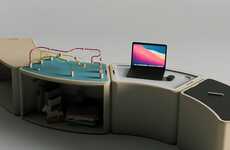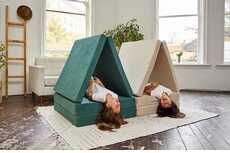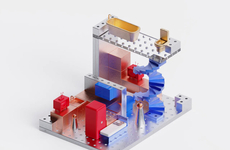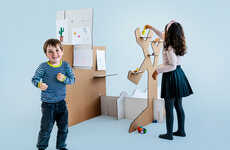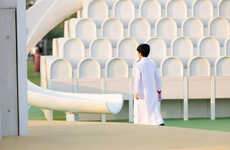
Grimshaw's 'MySpace' Cubby House Lets Kids Design Their Play Space
Joey Haar — April 28, 2017 — Art & Design
References: grimshaw.global & fastcodesign
Grimshaw, an international architecture firm, has recently designed a children's playhouse for the Cubby House Challenge. The firm's design features a modular layout that allows each child who interacts with it to reshape the space to their liking, offering up hundreds if not thousands of different potential formations.
MySpace, the name of Grimshaw's Cubby House Challenge entry, is a cubic frame encased in translucent plastic. Inside the frame is a four by four grid of simple timber shafts. MySpace is loaded and surrounded with cushioned sections that fit within the space of the grid, and kids can move those cushions anywhere.
The playhouse was designed not only to give kids a creative space, but to benefit kids without their own spaces as well. The Cubby House Challenge is a fundraiser for Kids Under Cover, an Australian youth homelessness nonprofit.
MySpace, the name of Grimshaw's Cubby House Challenge entry, is a cubic frame encased in translucent plastic. Inside the frame is a four by four grid of simple timber shafts. MySpace is loaded and surrounded with cushioned sections that fit within the space of the grid, and kids can move those cushions anywhere.
The playhouse was designed not only to give kids a creative space, but to benefit kids without their own spaces as well. The Cubby House Challenge is a fundraiser for Kids Under Cover, an Australian youth homelessness nonprofit.
Trend Themes
1. Modular Play Spaces - Innovations in modular play spaces allow children to design and reshape their play areas, promoting creativity and customization.
2. Interactive Playhouses - Interactive playhouses that offer customizable features and adaptable layouts provide children with endless possibilities for play and exploration.
3. Child-focused Design - Designing play spaces with a focus on children's input and preferences encourages creativity and fosters a sense of ownership in their play experiences.
Industry Implications
1. Architecture - The architecture industry can explore opportunities to create innovative and customizable modular play spaces that enhance children's play experiences.
2. Toy and Play Equipment - The toy and play equipment industry can develop interactive playhouses with adaptable features to meet children's changing preferences and needs.
3. Nonprofit Organizations - Nonprofit organizations focused on youth and homelessness can utilize modular play spaces to provide creative and engaging environments for children without their own spaces.
6.4
Score
Popularity
Activity
Freshness


